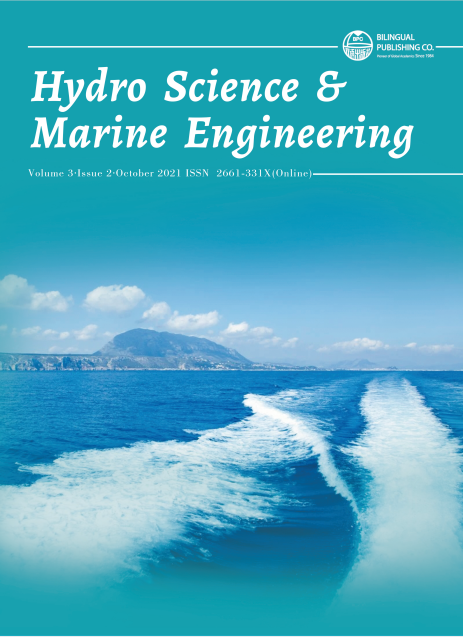Surface Water Quality Assessment of Panchagnaga River and Development of DO-BOD Relationship Using Empirical Approach
DOI:
https://doi.org/10.30564/hsme.v3i2.4121Abstract
Surface water samples were collected from selected locations along river Panchaganga, from Kolhapur to Narsobawadi during April 2019. Physicochemical parameters were determined in the laboratory and chemical mass balance approach was adopted to estimate the individual ionic loads in the river water. Streeter-Phelps equation was applied to derive a relationship between DO and BOD5. Model parameters such as De-oxygenation Rate (Kd) and Re-aeration Rates (Kr ) were optimized using different empirical methods. The result of chemical mass balance showed an increase in the loading of various ions from upstream to downstream which could be attributed to agricultural and industrial wastes that enter the main stream. De-oxygenation rate and re-aeration constants were calculated using various empirical methods. DO sag curve was developed using Streeter Phelp’s model and compared with the observed parameters which showed a significant correlation. DO-BOD concentration observed along the course of the river indicated that the self-purification capacity of the river is high due to which the river regains the lost DO level at a distance less than 50 meters.
Keywords:
DO-BOD, Streeter phelp’s model, DO sag curve, Chemical mass balance, Self purification capacityReferences
[1] Vipinchandra Shetty Ampar. Simple Water Quality Modelling .Dissertation, Department of Engineering Hydrology University College Galway Ireland
[2] Stephane Mbuyamba et al (2018).Modeling of Dissolved oxygen (O2) Dynamics on the Left Bank of the Congo River;Port Ex Onatra River City. American Scientific Research Journal for Engineering Technology, and Science (ASRJETS)(2018) Volume 45, No 1, pp1-19
[3] Gaikwad, S. S. (2014). Assessment of Heavy Metal Pollution of Panchganga River with Reference to Diversity of Molluscan Fauna. Dissertation, Shivaji University, Kolhapur. (Maharastra) India.
[4] APHA, Standard Methods for the Estimation of Water and Waste Water, American Public Health Association, New York, 2005.
[5] Streeter, H. W.; Phelps, E. B. A study of the natural purification of the Ohio River. Washington: U. S. Public Health Service, 1925. 75p. (Public Health Bulletin, v. 146APHA.(1998). Standard methods for the examination of water and wastewater (20th Ed). Washington: American Public Health Association. DC 20005-2605.
[6] Thomas, H. A., 1950, Graphical Determination of BOD Curves Constants, Water and Sewerage Works, Vol 97
[7] Hydroscience Inc, 1971, ―Simplified Mathematical Modeling of Water Quality Prepared for the Mitre Corporation and the USEPA, Water Programs, Washington D C, Mar 1971, 127 pp, 4 Appendixes. 5 Monographs
[8] Edward R. Holley et al,1984, Field Techniques for Reareation Measurements in Rivers. Gas Transfer at Water Surfaces,pp 381-401
[9] O’Connor, D. J., & Dobbins, W. E. (1956). Mechanism of reaeration in natural streams. Transactions of the American Society of Civil Engineers, 123, 641–684.)
[10] Churchill, M.A., Elmore, H.L., and Buckingham, R.A., (1962). Prediction of stream reaeration rates, J. San. Engr. Div ASCE SA4:1, Proc. Paper 3199.
[11] Owens M., Edwards R.W. and Gibbs J.W. (1964). Some reaeration studies in streams, Int. Jour. Air and Water Poll., 2. 469
[12] Langbein WB, Durum WH. The American Capacity of Streams, USGS Circular No. 542. Washington (DC): United States Geological Survey; 1967
[13] Jha R, Ojha CSP, Bhatia KKS. (2003). A supplementary approach for estimating reaeration rate coefficients. Hydrol Process. 18:6
[14] BIS, Indian Standard for drinking water- specifications IS: 10500:1991, Bureau of Indian Standards, New Delhi.
[15] BIS, I. (2012). 10500: 2012. Indian standard drinking water-specification (second revision), Bureau of Indian Standards, New Delhi
[16] Almeida, T. V. D. (2006.) Índice de qualidade da água e coeficientes de autodepuração de trechos do Rio Pomba. 2006. 68f. Dissertação (Mestrado em Engenharia Agrícola) - Universidade Federal de Viçosa, Viçosa
[17] Von Sperling, M. Introdução à qualidade das águas e ao tratamento de esgoto. 4. ed. Belo Horizonte: Departamento de Engenharia Sanitária e Ambiental; Universidade Federal de Minas Gerais, 2014. v. 1. 472 p.
[18] Bahadur, R.; Amstutz, D. E.; Samuels, W. B.( 2013). Water contamination modeling: a review of the state of the science. Journal of Water Resource and Protection, v. 5, p. 142-155,
[19] González, S. O.; Almeida, C. A.; Calderón, M.; Mallea, M. A.; González, P. Assessment of the water self-purification capacity on a river affected by organic pollution: application of chemometrics in spatial and temporal variations. Environmental Processes, v. 21, p. 10583-10593, 2014
Downloads
Issue
Article Type
License
Copyright and Licensing
The authors shall retain the copyright of their work but allow the Publisher to publish, copy, distribute, and convey the work.
Hydro Science & Marine Engineering publishes accepted manuscripts under Creative Commons Attribution-NonCommercial 4.0 International License (CC BY-NC 4.0). Authors who submit their papers for publication by Hydro Science & Marine Engineering agree to have the CC BY-NC 4.0 license applied to their work, and that anyone is allowed to reuse the article or part of it free of charge for non-commercial use. As long as you follow the license terms and original source is properly cited, anyone may copy, redistribute the material in any medium or format, remix, transform, and build upon the material.
License Policy for Reuse of Third-Party Materials
If a manuscript submitted to the journal contains the materials which are held in copyright by a third-party, authors are responsible for obtaining permissions from the copyright holder to reuse or republish any previously published figures, illustrations, charts, tables, photographs, and text excerpts, etc. When submitting a manuscript, official written proof of permission must be provided and clearly stated in the cover letter.
The editorial office of the journal has the right to reject/retract articles that reuse third-party materials without permission.
Journal Policies on Data Sharing
We encourage authors to share articles published in our journal to other data platforms, but only if it is noted that it has been published in this journal.




 Shilpa Yakkerimath
Shilpa Yakkerimath

